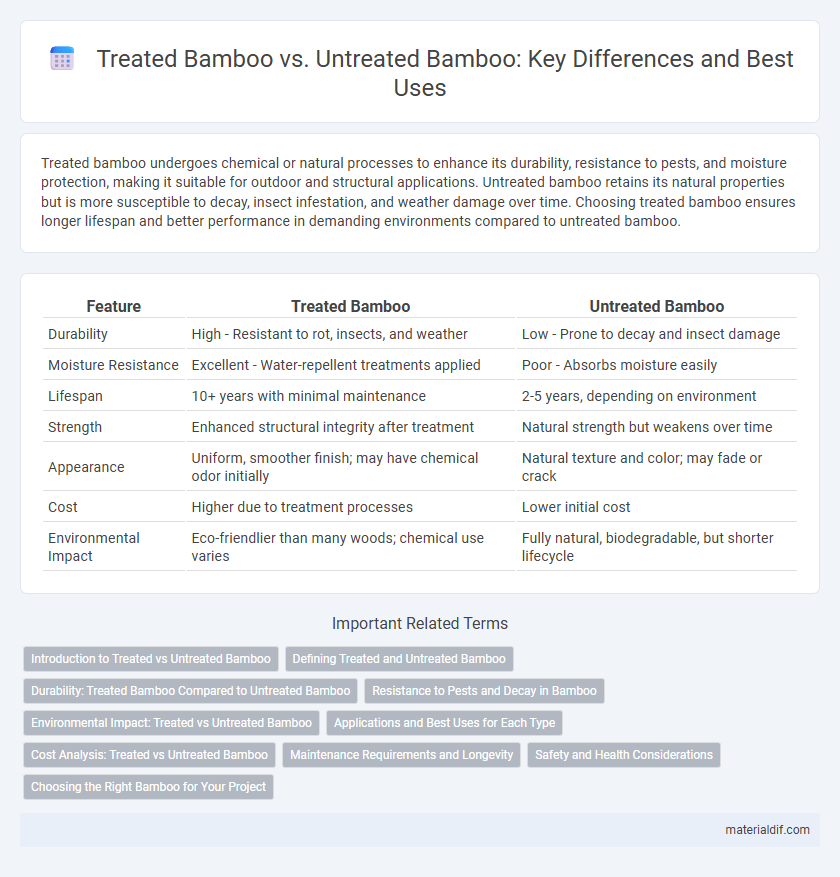Treated bamboo undergoes chemical or natural processes to enhance its durability, resistance to pests, and moisture protection, making it suitable for outdoor and structural applications. Untreated bamboo retains its natural properties but is more susceptible to decay, insect infestation, and weather damage over time. Choosing treated bamboo ensures longer lifespan and better performance in demanding environments compared to untreated bamboo.
Table of Comparison
| Feature | Treated Bamboo | Untreated Bamboo |
|---|---|---|
| Durability | High - Resistant to rot, insects, and weather | Low - Prone to decay and insect damage |
| Moisture Resistance | Excellent - Water-repellent treatments applied | Poor - Absorbs moisture easily |
| Lifespan | 10+ years with minimal maintenance | 2-5 years, depending on environment |
| Strength | Enhanced structural integrity after treatment | Natural strength but weakens over time |
| Appearance | Uniform, smoother finish; may have chemical odor initially | Natural texture and color; may fade or crack |
| Cost | Higher due to treatment processes | Lower initial cost |
| Environmental Impact | Eco-friendlier than many woods; chemical use varies | Fully natural, biodegradable, but shorter lifecycle |
Introduction to Treated vs Untreated Bamboo
Treated bamboo undergoes chemical or natural processes to enhance durability, resistance to pests, and moisture protection, making it suitable for construction and outdoor applications. Untreated bamboo retains its natural properties but is more susceptible to insect damage, mold, and environmental decay. Selecting treated bamboo extends lifespan and performance, particularly in harsh or humid conditions.
Defining Treated and Untreated Bamboo
Treated bamboo undergoes chemical or physical processes to enhance its durability, resistance to pests, and moisture absorption, making it suitable for construction and outdoor use. Untreated bamboo retains its natural properties without any preservation methods, resulting in higher vulnerability to decay, insect attacks, and environmental damage. The choice between treated and untreated bamboo depends on the intended application and desired longevity of the material.
Durability: Treated Bamboo Compared to Untreated Bamboo
Treated bamboo exhibits significantly higher durability than untreated bamboo due to its resistance to moisture, insects, and fungal attacks. The preservation process, often involving borates or heat treatment, enhances bamboo's structural integrity and prolongs its lifespan in outdoor and high-humidity environments. Untreated bamboo deteriorates quickly when exposed to weather elements, making treated bamboo the preferred choice for sustainable construction and furniture.
Resistance to Pests and Decay in Bamboo
Treated bamboo exhibits significantly enhanced resistance to pests and decay compared to untreated bamboo due to chemical preservatives that protect against fungi, insects, and moisture damage. Untreated bamboo is highly susceptible to termite infestation and fungal attacks, which compromise structural integrity and longevity. Proper treatment processes, such as borax-boric acid treatment or heat treatment, are essential for increasing bamboo's durability in construction and outdoor applications.
Environmental Impact: Treated vs Untreated Bamboo
Treated bamboo often involves chemical preservatives such as borates or copper-based solutions to enhance durability and pest resistance, which can introduce toxins into soil and waterways, negatively impacting ecosystems. Untreated bamboo, being free from chemical additives, decomposes naturally and supports soil health by returning nutrients without contaminating the environment. While treated bamboo extends the material's lifespan, untreated bamboo offers a more eco-friendly option with a lower environmental footprint in sustainable construction and product design.
Applications and Best Uses for Each Type
Treated bamboo is ideal for outdoor applications such as decking, fencing, and furniture due to its enhanced resistance to moisture, insects, and decay, extending durability in harsh environments. Untreated bamboo suits indoor uses like flooring, wall paneling, and decorative items where exposure to elements is minimal, preserving natural aesthetics and eco-friendliness. Selecting treated or untreated bamboo depends on the project's exposure, longevity requirements, and maintenance preferences, maximizing performance and sustainability.
Cost Analysis: Treated vs Untreated Bamboo
Treated bamboo incurs higher upfront costs due to processes like chemical preservation and heat treatment that extend durability and resistance to pests and moisture. Untreated bamboo is less expensive initially but may require frequent replacement and maintenance, increasing long-term expenses. Cost analysis reveals treated bamboo offers better value over time, reducing overall lifecycle costs despite the higher initial investment.
Maintenance Requirements and Longevity
Treated bamboo resists moisture, insects, and fungal decay, significantly reducing maintenance needs compared to untreated bamboo, which is prone to rotting and pest damage. Longevity of treated bamboo can exceed 20 years when properly maintained, while untreated bamboo often deteriorates within 5 to 7 years under similar conditions. Applying preservatives and protective coatings enhances the durability and lifespan of bamboo in outdoor and structural applications.
Safety and Health Considerations
Treated bamboo undergoes chemical or heat processes that enhance resistance to pests, mold, and decay, significantly improving its durability and safety for structural use. Untreated bamboo remains more susceptible to insect infestation and fungal growth, posing potential health risks and structural instability over time. Proper treatment methods reduce the likelihood of allergic reactions and exposure to harmful microorganisms, ensuring safer applications in construction and household products.
Choosing the Right Bamboo for Your Project
Treated bamboo offers enhanced durability and resistance against pests, moisture, and decay, making it ideal for outdoor and structural projects requiring longevity. Untreated bamboo retains its natural appearance and chemical-free qualities but requires careful maintenance and protection to prevent damage over time. Selecting treated or untreated bamboo depends on project exposure, desired lifespan, and environmental considerations.
treated bamboo vs untreated bamboo Infographic

 materialdif.com
materialdif.com